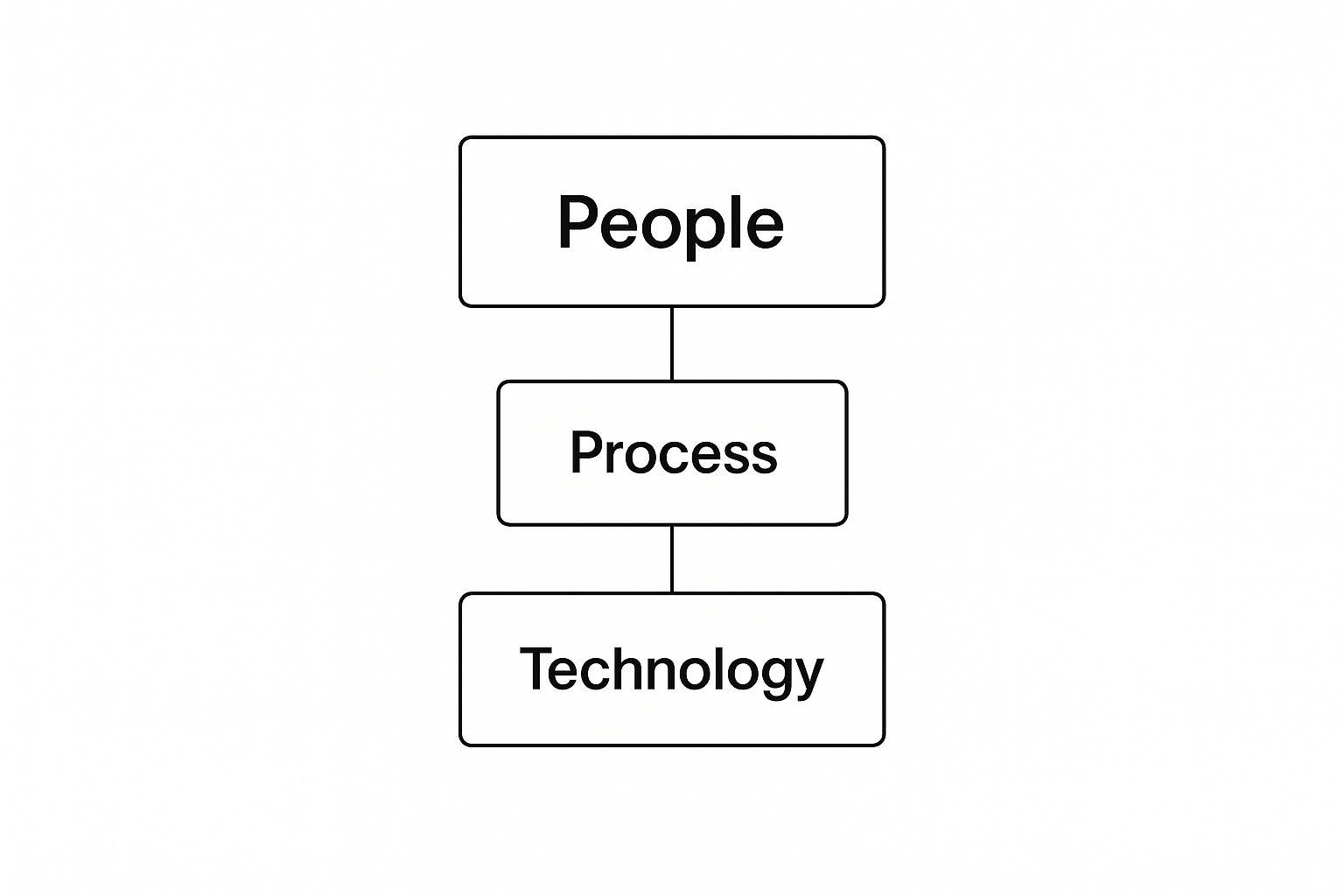When you hear Customer Experience Management, or CXM, what comes to mind? It’s not just another business acronym. It’s the art and science of thoughtfully designing every single touchpoint a customer has with your brand.
Think of it as a proactive strategy—understanding, shaping, and constantly improving the entire customer journey. The goal? To build genuine loyalty and transform happy customers into your most powerful advocates.
The Director’s Cut of Your Brand’s Story

Imagine a great film director crafting a masterpiece. They don’t just focus on the final, dramatic scene. No, they obsess over the lighting, the score, and the performance in every single frame. They know that each tiny detail contributes to a powerful, cohesive story that sticks with the audience long after the credits roll.
That’s exactly what customer experience management does for your brand. It’s about orchestrating all those customer interactions—from the first ad they see to the support ticket they submit—to create a positive, consistent, and truly memorable feeling about your company. It’s a huge leap from just reacting to problems as they pop up.
Customer experience (CX) is how consumers feel about your business throughout the customer journey, from initial awareness to post-purchase interactions. It has a strong impact on revenue and customer loyalty.
Shifting from Reactive to Proactive
A lot of businesses fall into the trap of thinking CX is just about closing support tickets or handling complaints. While that’s certainly part of the picture, real customer experience management is about preventing those issues from ever happening. It’s the difference between stationing a lifeguard at the beach (reactive) and teaching everyone how to swim safely in the first place (proactive).
To get there, you need a deep, empathetic understanding of what your customers need, think, and feel at every single stage. This proactive mindset involves a few core activities:
- Mapping the Journey: You have to identify every single point of contact. This means everything from the moment someone stumbles upon your brand on social media to the unboxing experience and their first interaction with your support team.
- Listening for Feedback: This isn’t passive. It’s about actively collecting and digging into customer sentiment through surveys, online reviews, and direct conversations. What are they really saying?
- Designing for Emotion: The best experiences aren’t just functional; they’re emotionally resonant. CXM is about intentionally creating interactions that feel positive, effortless, and maybe even a little delightful.
To give you a clearer picture, here’s a breakdown of the core principles that separate true CXM from simple customer service.
Core Tenets of Customer Experience Management
| Principle | Description |
|---|---|
| Holistic View | It’s not about a single interaction, but the sum of all parts of the journey. |
| Proactive Design | Instead of just fixing problems, you anticipate needs and design smoother paths. |
| Customer-Centric Culture | Every team and every decision is guided by the question: “How does this impact the customer?” |
| Data-Driven Empathy | You use data not just for metrics, but to genuinely understand customer feelings and pain points. |
| Continuous Improvement | The customer journey is never “done.” It’s a living thing that needs constant attention and refinement. |
By embracing these tenets, you move your organization from constantly putting out fires to building a fire-resistant structure from the ground up.
Why CXM Is More Important Than Ever
The money tells the story. The global Customer Experience Management market was valued at USD 15.17 billion and is on track to explode to USD 64.51 billion by 2034. Why the massive investment? Because businesses have realized that keeping an existing customer happy delivers a far better financial return than constantly chasing new ones.
Ultimately, CXM isn’t a department you can silo away; it’s a company-wide philosophy. It’s about putting the customer at the absolute center of every decision, every process, and every new idea. For anyone ready to dig in and start making changes, our guide on customer experience optimization is a great place to find practical next steps.
When you manage the entire experience, you build relationships that can weather a competitive storm. You create a loyal following of advocates who end up being the most authentic and effective marketing asset you could ever ask for.
Why CXM Is Your New Competitive Advantage
In a crowded marketplace, where everyone’s products and services start to look the same, the old battles over price and features are fading. The real fight, the one that defines winners, is now all about experience. Customer experience management (CXM) has gone from a “nice-to-have” to the single biggest differentiator setting successful brands apart.
When you deliver an exceptional experience, something powerful happens. Customers who feel seen and valued don’t just make a single purchase; they stick around. This is the heart of customer retention, the financial bedrock of any sustainable business. It’s a simple truth: getting a new customer in the door costs a whole lot more than keeping an existing one happy.

Driving Revenue and Brand Reputation
A solid CXM strategy is a direct line to growth because it boosts customer lifetime value (CLV). A happy customer is far more likely to buy from you again, try out new offerings, and stay loyal even if a competitor dangles a small discount. Once you truly grasp that CXM directly fuels this kind of long-term loyalty, you’ll see why exploring effective customer retention marketing strategies becomes a no-brainer.
But it’s not just about the immediate revenue. CXM builds an ironclad brand reputation. Your satisfied customers become your most powerful and authentic marketing team. They leave glowing reviews, rave about you to friends and family, and even defend your brand online. This is the kind of organic, word-of-mouth marketing that no amount of ad spend can ever truly replicate. For a deeper dive, check out our guide on how to improve customer satisfaction.
The Growing Market for Experience
This laser focus on experience isn’t just a fleeting trend—it’s a massive market force. The Customer Experience Management market, already valued at around USD 14.23 billion, is on track to nearly double to USD 26.44 billion in the next few years.
That’s an explosive compound annual growth rate (CAGR) of 16.8%. It’s a clear signal that businesses are putting their money where their mouth is, betting big on experience as the key to winning.
Building Your CXM Strategy From the Ground Up
A powerful customer experience strategy isn’t something that just happens. It’s built on purpose, piece by piece, on a solid foundation of a few essential pillars. When you get this framework right, you have a blueprint for turning random customer interactions into a connected, positive journey that builds real loyalty.
First things first: you have to deeply understand your customer. I’m not just talking about basic demographics. This means creating detailed customer personas that get to the heart of their motivations, what they need, and where their frustrations lie. You need to be able to walk a mile in their shoes.
This naturally leads to the next step: mapping the customer journey. Think about every single touchpoint a customer has with your business—from seeing an ad to getting an invoice. Visualizing this path helps you spot the “moments of truth” that make or break their experience. The real goal is to see your business from their perspective and uncover friction points you didn’t even know were there. To chart this course, many teams use dedicated customer experience mapping tools to make sense of the complexity.
Turning Insight Into Action
Once you have a map of the journey, you need to gather and analyze meaningful feedback. This goes way beyond an annual survey. It means using a smart mix of methods, like Net Promoter Score (NPS) to measure loyalty, social listening to catch what people are saying unprompted, and direct feedback from your own support teams on the front lines.
But gathering insights is pointless if you don’t act on them. This is where you personalize the experience. Using the data you’ve collected, you can tailor your communication and offers. This makes customers feel like you see them as individuals, not just another number on a spreadsheet.
“Research has shown that the better the fit between a customer’s needs and preferences and the attributes of a service offering, the higher the satisfaction customers report. And the higher the satisfaction customers report, the higher their long-term loyalty.” – Harvard Business School
A crucial part of any CXM strategy is having a winning omnichannel communication strategy to make sure every interaction feels like part of the same seamless conversation.
Fostering a Customer-Centric Culture
Finally, and this is the big one, you have to foster a customer-centric culture. This is the pillar that holds everything else up. It means everyone, from the CEO down to the newest intern, is obsessed with delivering a fantastic customer experience. When CXM is baked into your company’s DNA, it’s no longer a “program”—it’s just how you do business.
This diagram shows how people, processes, and technology all need to line up to create a true customer-first culture.

This visual really drives home a core truth of CXM: technology and processes are just tools. Their only job is to empower your people to deliver incredible service.
How to Measure What Truly Matters in CX

You’ve probably heard the old saying, “You can’t improve what you don’t measure.” In the world of customer experience management, that’s not just a cliché—it’s a fundamental truth. Flying blind with your CX strategy is a recipe for guesswork and wasted effort. You need hard data to see what’s working, get your team on board, and prove you’re actually making a difference.
These numbers are much more than just metrics on a dashboard. They tell the story of your relationship with your customers. When you track the right things, you can draw a straight line from a good score to real business results, like showing how a smoother experience slashed customer churn or boosted repeat sales.
The Three Core CX Metrics
To truly understand your customer experience, you need to look at it from a few different angles. While you could track dozens of numbers, most successful CX programs build their foundation on three core metrics. Think of them as different lenses that, when combined, give you a complete picture.
These “big three” are:
- Net Promoter Score (NPS): This is all about long-term loyalty. It answers the ultimate question: “How likely are you to recommend us to a friend or colleague?” It’s your benchmark for brand advocacy.
- Customer Satisfaction (CSAT): This metric gives you a real-time pulse check. It measures happiness with a specific interaction, like right after a support ticket is closed or an order is delivered.
- Customer Effort Score (CES): This one gauges how easy it was for a customer to get something done. Was it a breeze to resolve their issue, or did they have to jump through hoops? A low-effort experience almost always leads to a more loyal customer.
CXM Metrics Comparison
To get the most out of these metrics, it’s crucial to understand their distinct roles. Each one provides a unique piece of the CX puzzle, and using them at the right time in the customer journey is key to unlocking actionable insights.
This table breaks down what each primary metric measures and the best situations to use them in.
| Metric | What It Measures | Primary Use Case |
|---|---|---|
| Net Promoter Score (NPS) | Overall brand loyalty and likelihood to recommend. | Periodic relationship check-ins (e.g., quarterly or annually) to gauge long-term sentiment. |
| Customer Satisfaction (CSAT) | Immediate happiness with a single transaction or interaction. | Post-interaction feedback (e.g., after a support chat, purchase, or service appointment). |
| Customer Effort Score (CES) | The ease of a customer’s experience in getting an issue resolved or a goal met. | After a customer has completed a specific task, especially one involving a service or support process. |
By strategically deploying these metrics, you can create a feedback loop that constantly informs your CXM strategy, ensuring you’re focusing your efforts where they’ll have the biggest impact.
Putting Metrics Into Practice
Each metric has its moment to shine. CSAT is perfect for that immediate feedback right after an interaction. NPS, on the other hand, is better for those periodic check-ins to see how customers feel about your brand overall. A huge part of this is knowing how to measure customer satisfaction effectively to ensure the data you’re collecting is both accurate and useful.
But just collecting scores isn’t the point. The real magic happens when you start analyzing trends, digging into the “why” behind the numbers, and using that insight to fix real problems in the customer journey.
This is where it all comes together. A low CSAT score on a support ticket might be explained by a high CES—the process was just too hard. By connecting these dots, which is central to smart customer data integration best practices, you can pinpoint the exact points of friction and take action. This is how what is customer experience management evolves from a fuzzy concept into a measurable, data-driven engine for your business.
Putting Your CXM Program Into Action
Okay, so you understand the theory behind customer experience management. Now for the hard part: making it happen. Shifting from theory to a real, working CXM program requires a clear roadmap. This isn’t something that happens by accident; it’s a deliberate strategy built on leadership, empowered teams, and the right tech to turn customer insights into amazing experiences.
The absolute first step? Getting leadership buy-in. A genuine, top-down commitment is what elevates CXM from a small departmental project to a company-wide philosophy. When your leaders are championing the customer, it sends a crystal-clear message that this is a core business priority, not just another buzzword of the month.
Empowering Your Frontline Teams
Think about it: who really represents your brand to customers every day? It’s your frontline people—the support agents, sales reps, and field technicians. They are your most valuable asset for delivering a great experience, and giving them the tools and freedom to do their jobs well is non-negotiable.
This means they need access to customer data, the authority to solve problems without getting stuck in endless escalation chains, and continuous training. For example, a support agent who can see a customer’s entire history can provide a personalized, fast solution instead of asking the same frustrating questions over and over. To get your team ready, it’s worth brushing up on the latest help desk best practices for 2025 that are all about agent empowerment.
Leveraging Technology and Closing the Loop
Technology is the engine that powers any modern CXM strategy. Tools like Customer Relationship Management (CRM) systems and AI analytics are what let you dig through mountains of customer data to find those golden nuggets of insight. They make it possible to build the seamless, omnichannel journeys that customers don’t just want anymore—they expect.
You can see just how much businesses are betting on this by looking at the market. The Customer Experience Management sector is already valued at a hefty USD 22.44 billion and is on track to hit USD 51.11 billion soon. That’s a massive investment in these capabilities. You can dig deeper into these market trends on Mordor Intelligence.
But there’s one final, crucial piece to this puzzle: “closing the loop.” This simply means you don’t just collect feedback—you act on it. And then, you tell your customers what you did.
Sending a quick message like, “Thanks to your feedback, we’ve updated our checkout process to be faster,” does so much more than just fix an issue. It proves you’re listening, it builds incredible trust, and it makes that customer relationship stronger for the long haul.
Delivering a World-Class Global Customer Experience
A truly world-class customer experience has to cross borders and speak the customer’s language—literally. As businesses grow and tap into global markets, they hit a major hurdle: how do you provide consistent, top-notch support to a customer base that speaks dozens of different languages?
If you’re only offering support in English, you’re creating friction. It sends a clear message to your international customers that they’re an afterthought.
Effective customer experience management on a global scale is all about making sure every single customer feels heard and understood, no matter where they are or what language they speak. This is where technology steps in to tear down those communication walls. We’re not talking about the logistical nightmare of hiring an army of multilingual agents. The smart move is to embed translation capabilities right into the tools your service desk already uses every day.
Overcoming Language Barriers in Real Time
Modern tools are built to make multilingual support feel completely natural for both your agents and your customers. Take a solution like Issue Translation for Jira Service Management, for example. It allows a support team to handle conversations in over 100 languages without ever leaving their familiar Jira environment.
This simple shift empowers your agents to provide clear, helpful, and personal service to every customer, every time.
Here’s what that looks like in practice. The agent sees the customer’s original comment in German, with an instant English translation right below it—all inside the Jira ticket.
The magic here is in the clarity and context. The agent grasps the customer’s exact meaning and can write a reply in their own language, which is then translated back to the customer. No more awkward, stilted conversations.
This approach transforms multilingual support from a complex headache into a fluid, natural conversation. It allows your company to:
- Provide instant support without making customers wait for a specialized translator to become available.
- Maintain your brand voice by giving agents the power to edit and refine AI-powered translations before sending.
- Build a loyal global fanbase by proving to international customers that they’re just as important as your local ones.
Ultimately, delivering a world-class global experience isn’t just about plugging in an automated translator. It’s about using technology to build genuine human connections, making customers worldwide feel completely supported and deeply understood. This has become a cornerstone of any successful modern customer experience management strategy.
Common Questions About Customer Experience Management
As you start wrapping your head around what customer experience management means for your business, a few questions always seem to pop up. Getting straight answers is the key to moving from just understanding the idea to actually doing something effective with it.
Let’s tackle some of the most common queries.
What Is the Difference Between Customer Service and Customer Experience?
It helps to think of customer service as a single piece of a much larger puzzle. It’s usually a specific, reactive moment—like when a customer calls you with a problem or emails a question. It’s a critical scene in the movie, but it’s just one scene.
Customer experience (CX), on the other hand, is the entire movie. It’s the sum total of every single perception a customer forms about your company. This covers everything from the first ad they see, to how easy your website is to use, to the product itself, and yes, to that call with customer service. CX is the overall feeling they’re left with after all those touchpoints are added up.
How Can a Small Business Implement Customer Experience Management?
You absolutely don’t need a huge budget or a special department to get started with customer experience. For small businesses, the biggest wins come from nailing the fundamentals.
First, just try to map out your customer’s journey. Where do they interact with you? Then, start asking for feedback using simple tools like email surveys or polls on social media. Most importantly, listen. Your customer reviews and social media mentions are goldmines of honest, unfiltered insight.
The main goal for a small business is to make every interaction feel personal and show customers you genuinely appreciate them. Focus on building relationships and using their feedback to make small, consistent tweaks. Those little improvements really add up over time.
What Is the ROI of Investing in CXM?
The return on a good customer experience is very real and totally measurable. When you improve the experience, you directly see higher customer retention, which is always cheaper than finding new customers.
On top of that, happy customers tend to spend more over their lifetime with you, which boosts your Customer Lifetime Value (CLV). They also turn into your best marketers, spreading the word about your brand for free and building trust in a way that ads just can’t. You can track this ROI by looking at metrics like your customer churn rate, CLV, and referral rates before and after you start focusing on the experience.
Ready to deliver world-class support to your global customers? resolution Reichert Network Solutions GmbH makes it simple. Break down language barriers and build stronger customer relationships with Issue Translation for JSM.
